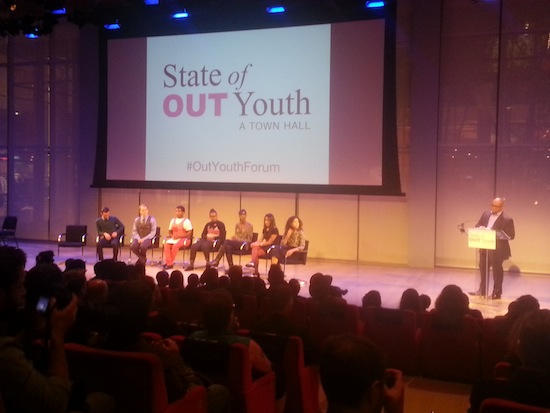 Last night four national LGBTQ organizations banded together to present “State of Out Youth,” a panel discussion with young people to discuss the issues facing youth today. Gay, Lesbian & Straight Education Network (GLSEN), Human Rights Campaign Foundation, The Trevor Project and True Colors Fund recruited the panelists and also presented a string of facts and figured that outlined the challenges facing these young people.
Last night four national LGBTQ organizations banded together to present “State of Out Youth,” a panel discussion with young people to discuss the issues facing youth today. Gay, Lesbian & Straight Education Network (GLSEN), Human Rights Campaign Foundation, The Trevor Project and True Colors Fund recruited the panelists and also presented a string of facts and figured that outlined the challenges facing these young people.
There was a great video presentation that opened the panel featuring an array of figures, most of which showed exactly how far youth still need to come to feel safe and protected. Hopefully the video will get posted and I’ll update this post with it. Here are a few of the stats from the panel’s website.
- More than half of LGBT youth say they are out to their family. Only one-fourth are out to their extended family.
- 63% of LGBT youth say they’ll need to move to another part of the country to feel accepted.
- 81.9% of LGBT students report being verbally harassed at schools in the past year because of their sexual orientation.
- LGBT youth are four times more likely to attempt suicide as their straight peers.
- 33% of LGBT youth say their family is not accepting of LGBT people.
- Family rejection is most often cited as the reason for LGBT youth homelessness.
Even with these disturbing statistics, the evening was not a downer. Instead, singer/songwriter Cyndi Lauper, the co-founder of True Colors Fund, started the evening off with a welcome that focused on the strength that a lot of these youth have. The strength was evident on the panel last night, which was a cross sex of race, sexuality and gender.

Here are a few things that stuck with me from the discussion:
- Alyx grew up in rural Montana. He knew he was gay from a very early age, but where he grew up there were no supportive LGBT spaces. He said that made him learn how to advocate for himself and made him grow into a resource to support others. While it made him stronger to go this route, he wondered why youth are left to speak for themselves rather than having adult allies to help them.
- Liam called on everyone to challenge the use of homophobic words. Having someone else speak up can affirm the student’s identity and help them feel safe. Be willing to be a brave adult. When you say nothing you’re condoning it.
- Shantey noted that having your identity brushed aside by your family can be just as hurtful as being kicked out of the house.
- ZiZi said that living your own truth is the invigorating part of life. She also said that it was okay to be ignorant, but it was wrong to be aggressively ignorant. That resonates so loud to me, because the ignorant can be taught about what’s happening around them, while the aggressively ignorant can often become violent and oppressive.
- I didn’t note down who said this, but it’s a truth: each human being is a lot more dynamic than the labels we stick on them.
- For the first time I also considered in more detail the LGBTQ designation. The L-G-B relate to sexuality, while Transgender (and possibly also Queer, I’m honestly not sure but I want to find out) relate to gender identity. Some of the panelists started to touch on this, wondering how sexuality and gender had become wrapped up together when they are in so many ways separate things. I have no idea what the answer is here (or if there’s even a right answer), but I came away wanting to know more about this, so I have some research to do.
I’m glad Jama–my friend, fellow Cycle for the Cause rider, and someone I got to know while I was a life coach for the Ali Forney Center–invited me to this. It was powerful hearing about these topics from the teens and young adults themselves rather than hearing/reading it second hand. Even though the LGBT community as a whole has made so many advances in the past few years, there is so much left to do to ensure equality and safety for all. And that is so important for the younger ones who are vulnerable if they don’t have proper support.
The panel gave me interesting food for thought for one of my possible Hat Trick sequels. In the story I’m thinking about, Simon has the opportunity to meet a array of LGTBQ teens. If I’m going to create these characters, I want to make sure they come across as real people–not caricatures or two dimensional, shallow characters. Hearing from these teens last night, will definitely help me as I continue to flesh out this story’s possibilities.
